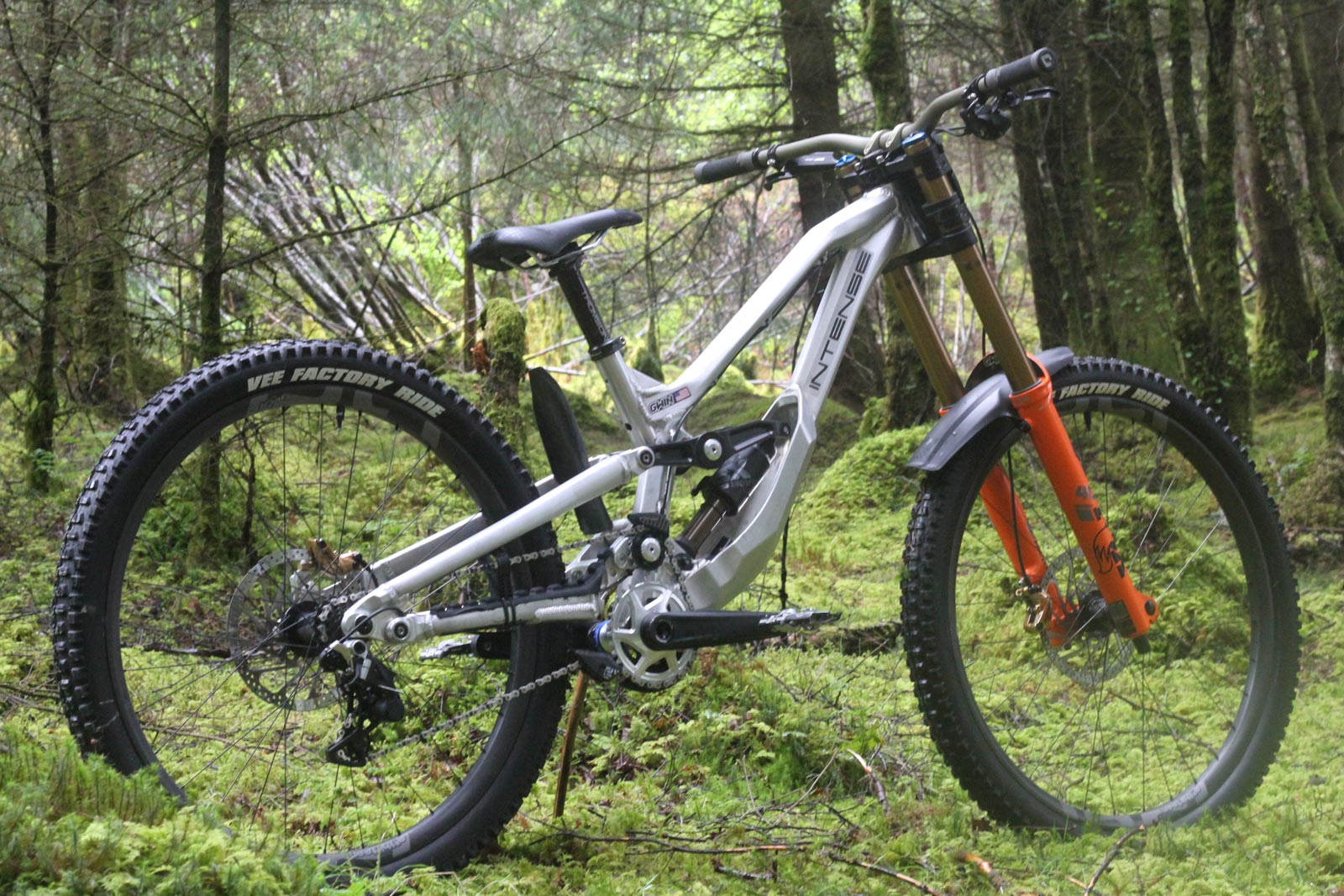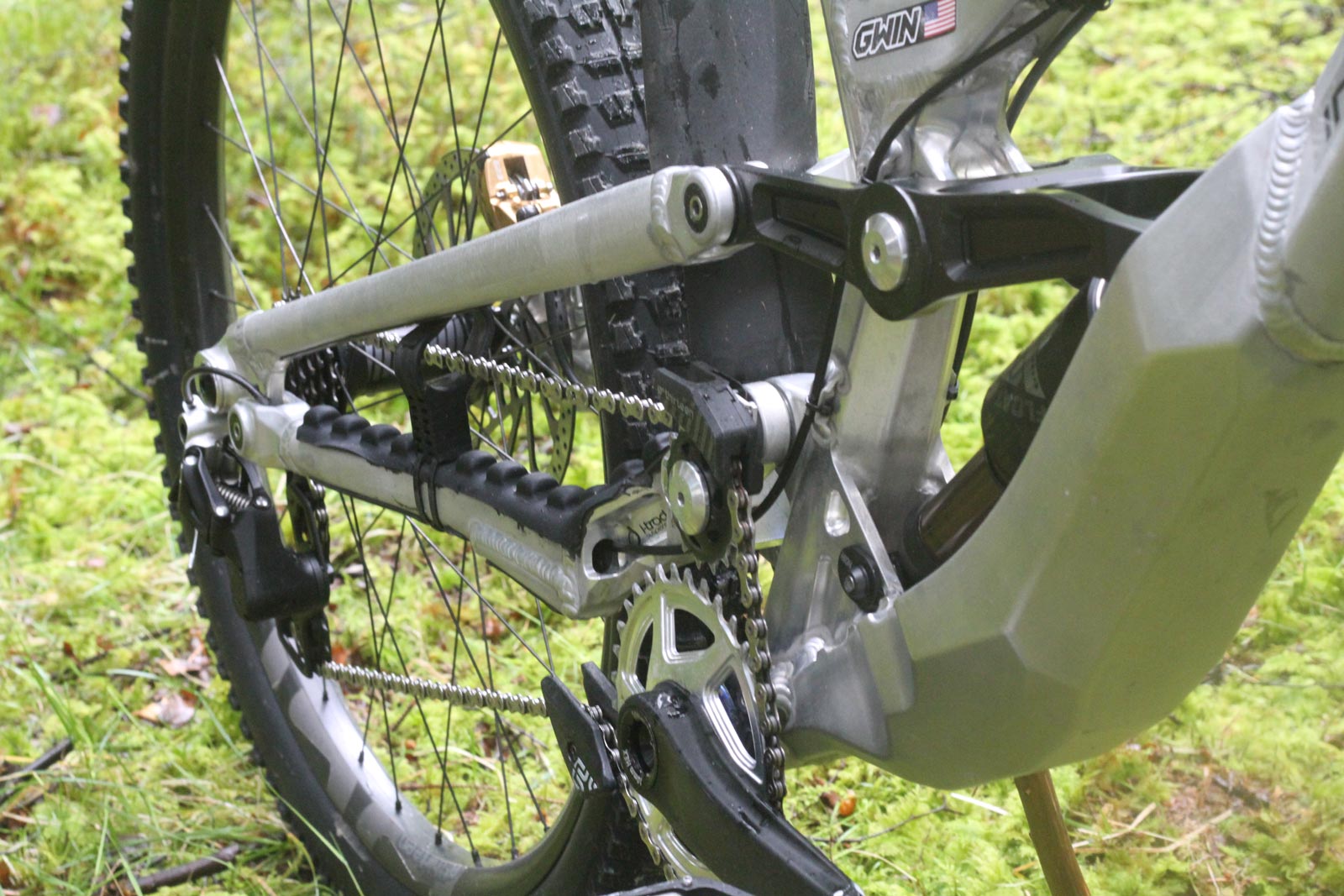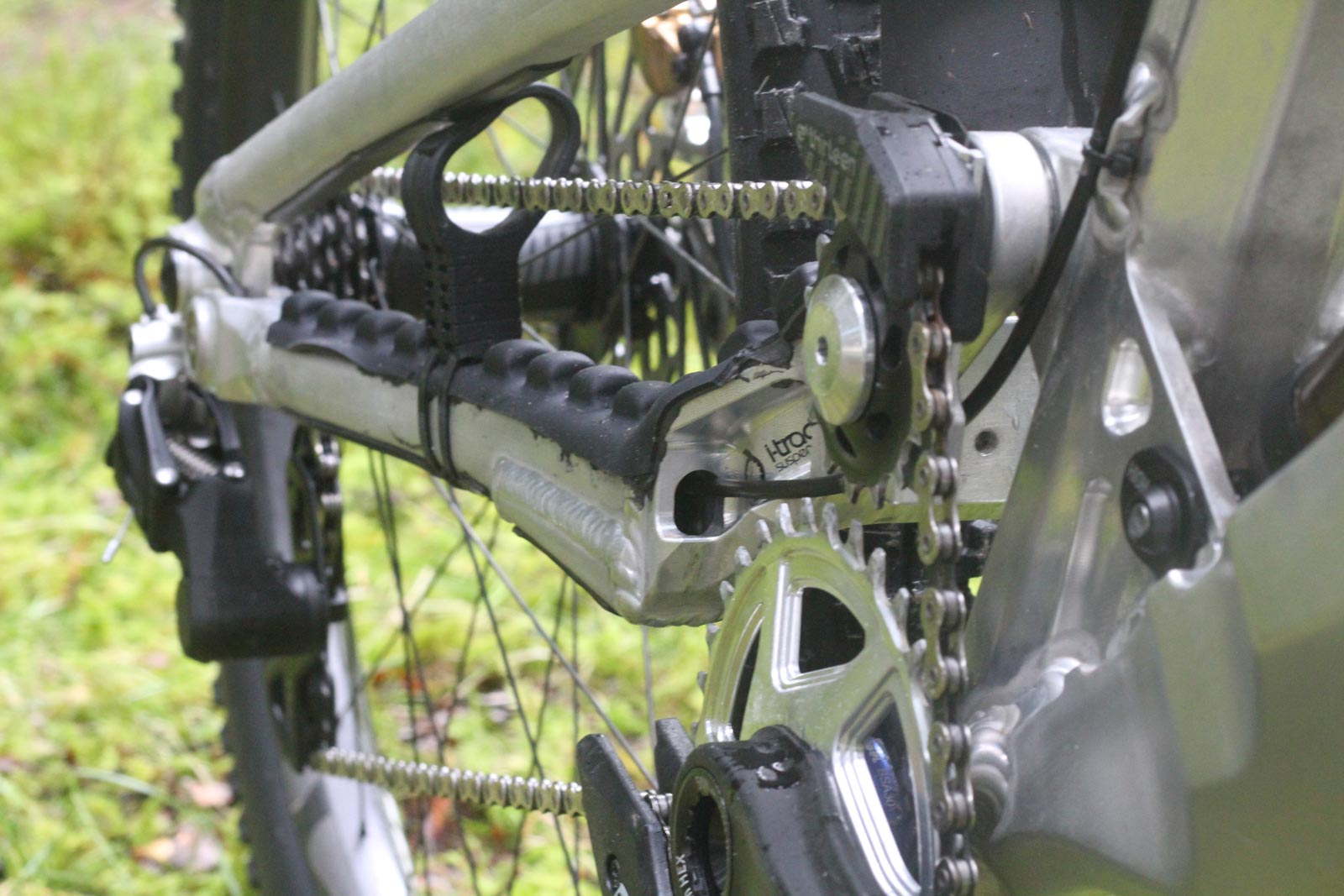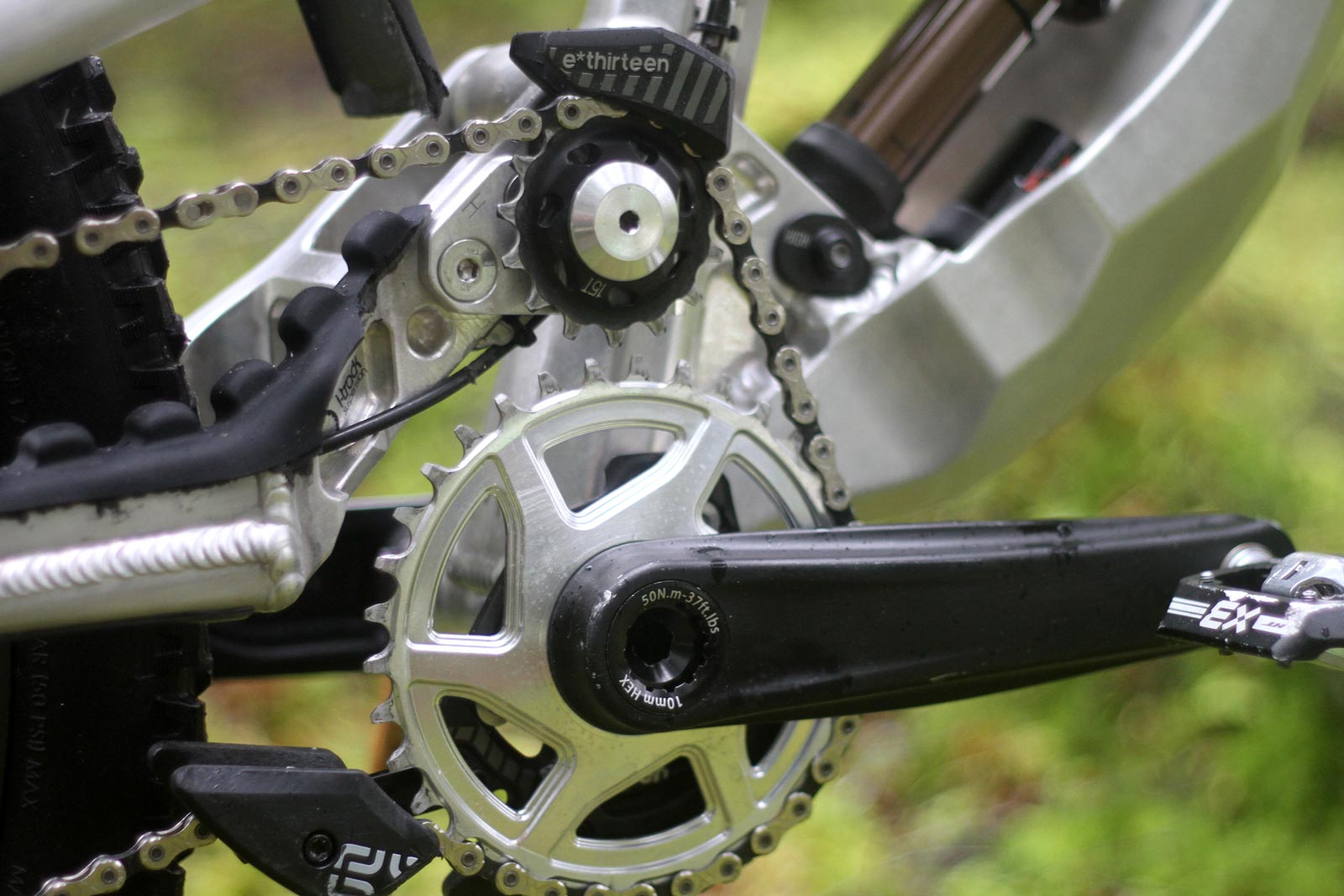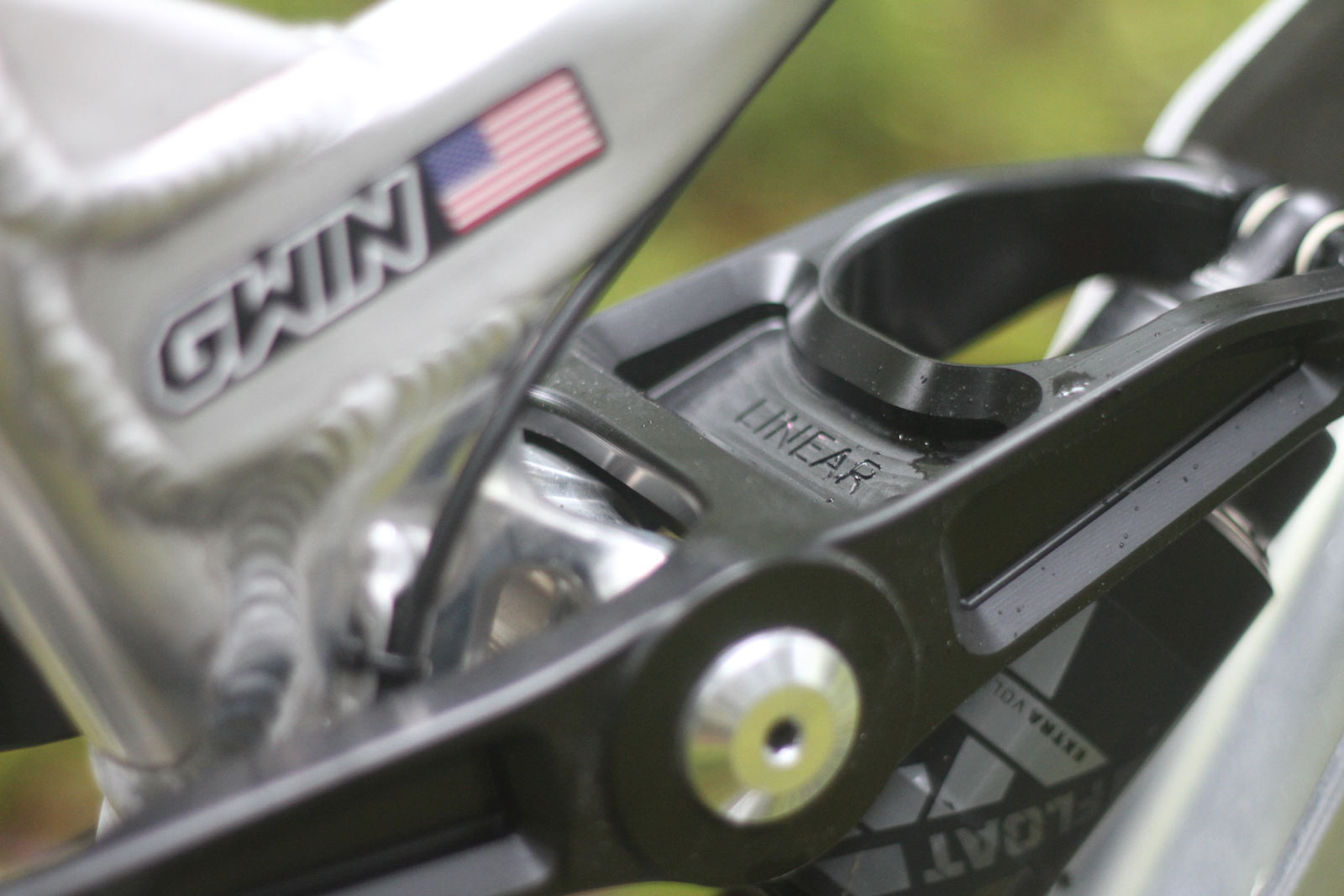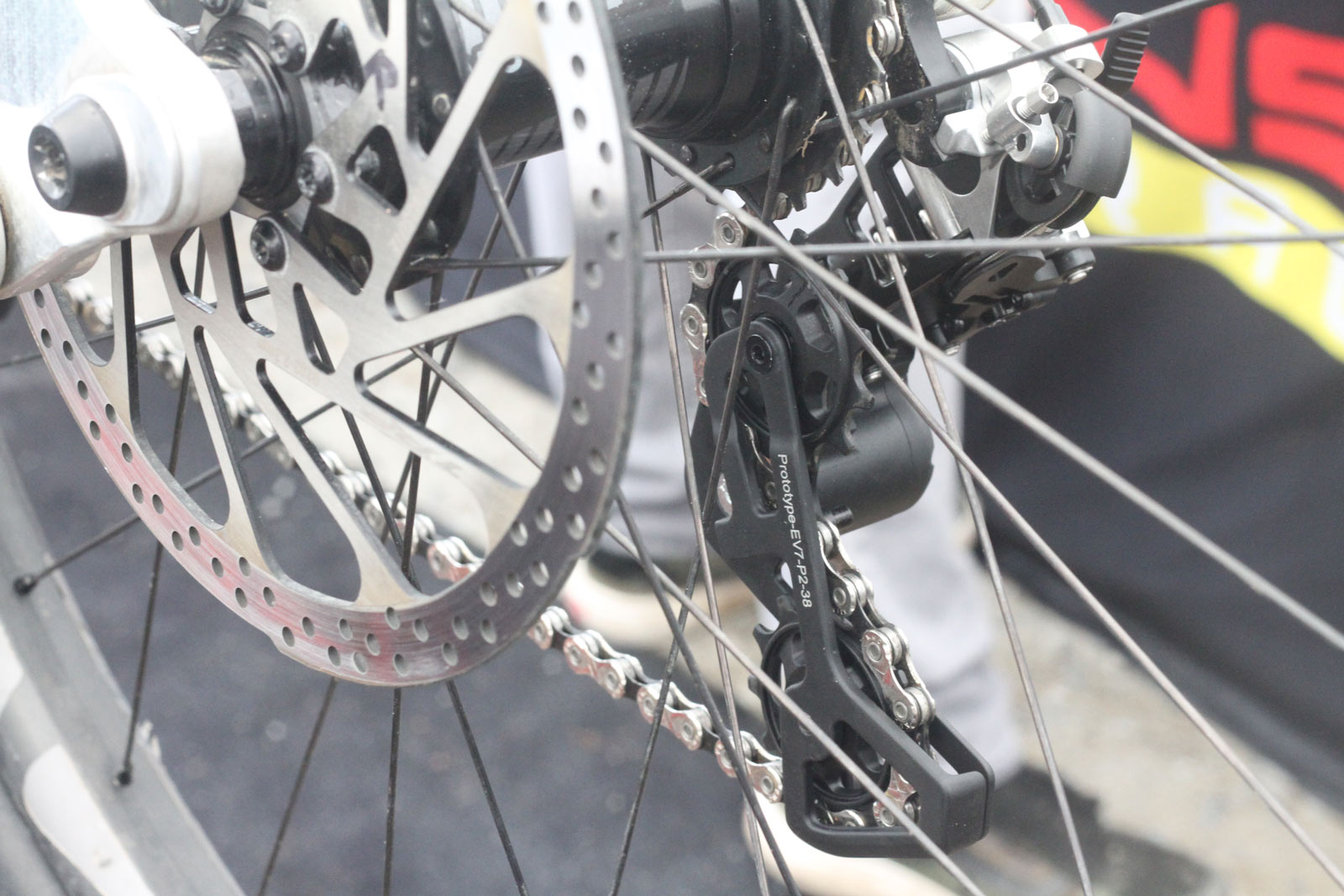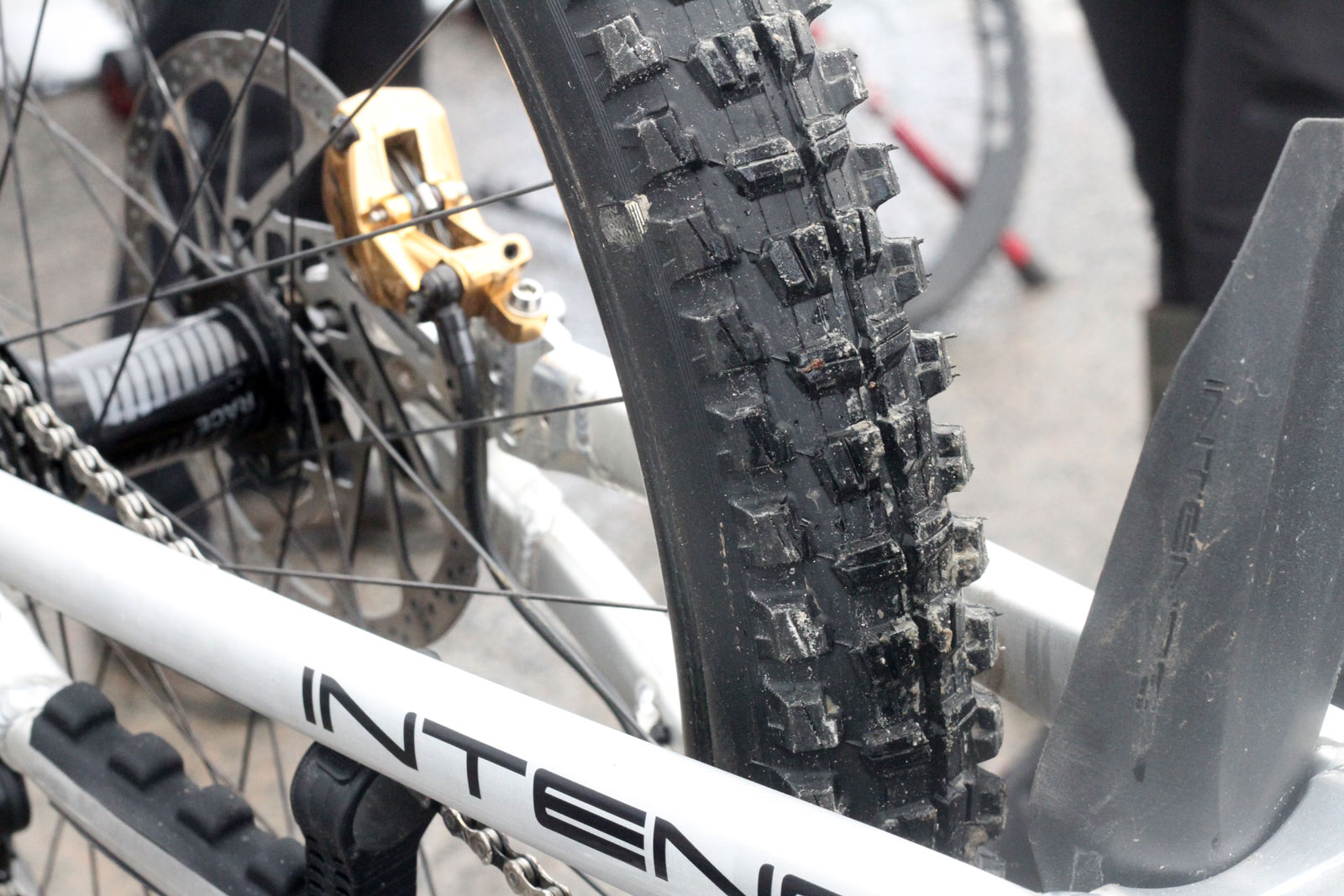Intense Cycles has had a new downhill bike in the works for some time now, first spotted under Aaron Gwin in some Vee Tire Co promotional photos for the announcement of their support of Intense Factory Racing. The bikes piloted by Aaron and his Intense Factory Racing team mates at Fort William last weekend are still very much prototypes, and we still aren’t able to confirm whether any of the technology you’re about to read about will go into production.
Either way, given the team are no longer racing the current M29, for all intents and purposes it can be said that Intense has moved away from the VPP linkage. It is replaced by a new high pivot location on a four bar linkage, complete with idler pulley to isolate the majority of drivetrain forces from those of the suspension. Printed on the drive-side of the rear swingarm are the word “i-track suspension”, alongside i-track’s logo. We have not yet had conformation from Intense, but it does look as though Intense Cycles are making use of at least some aspects of the i-track suspension design. Murmurings on the i-track Facebook Page, (where they are calling this bike the M279 HP1) would certainly suggest this is so.
Unfortunately, Gwin’s weekend was cut short when he failed to qualify for finals. What felt like half of the Elite Men’s field came down through the Scotland Arch with very little air pressure in the rear tire; sadly, Aaron was one of them. A quiet Sunday morning for Aaron meant that his mechanic, John Hall (of TRP Hall Lock fame), was available to talk us through the new rig.
Aaron Gwin’s Prototype Intense DH Bike
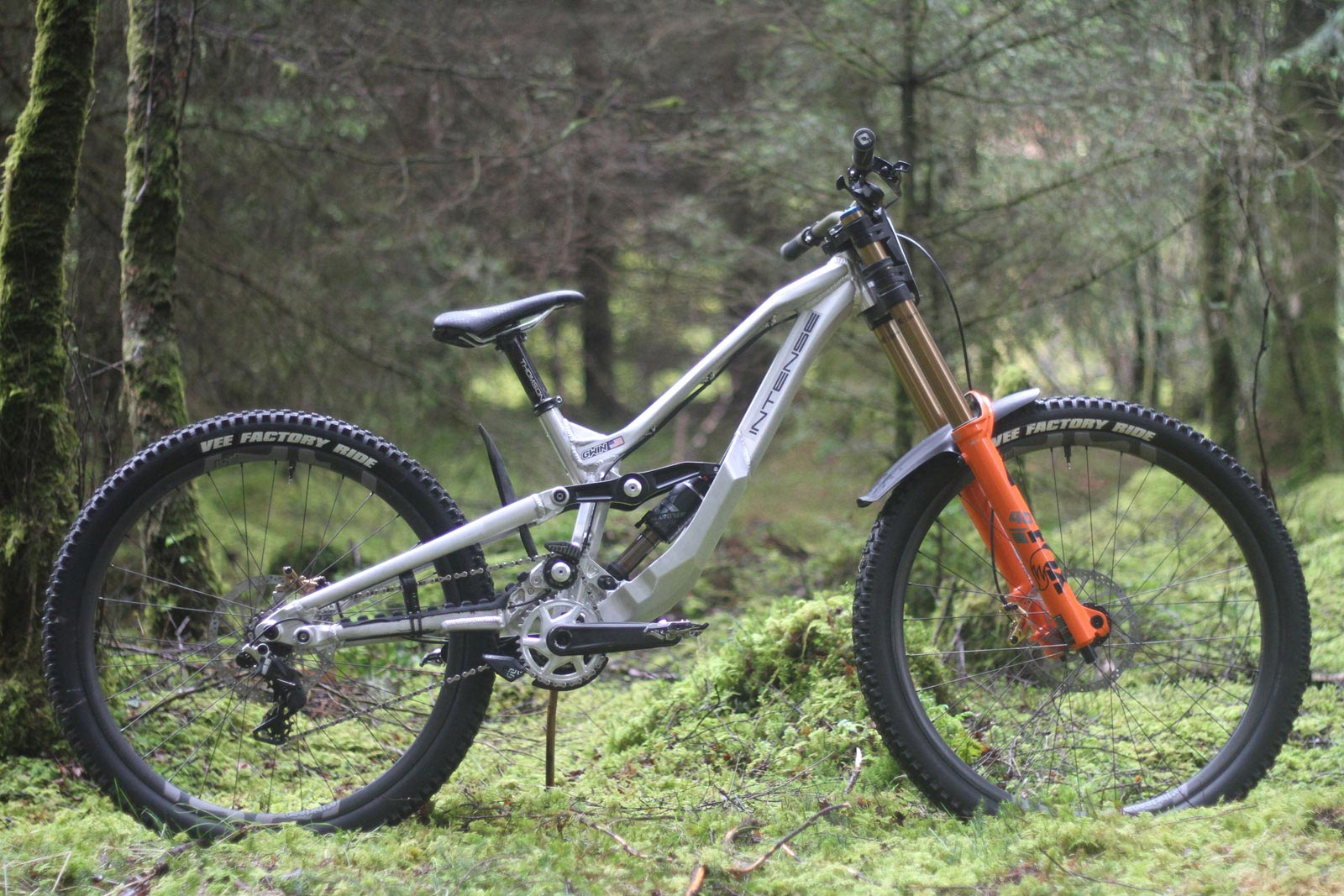
Intense Cycles’ switch to a high-pivot suspension linkage comes as a surprise to no one, really. Convincing wins by Gracie Hemstreet aboard the Norco Range, Valentina Höll on the Trek Session, Amaury Pierron, Myriam Nicole and Camille Balanche aboard the Commencal Supreme DH V5, as well as the numerous podiums it has put Benoit Coulanges and Thibaut Daprela on, show this trend is more than just a fad. Looking at kinematic, there is a strong argument for a linkage that delivers a majority rearward axle path, especially in the discipline of Downhill.
Nevertheless, to understand the approach of Jeff Steber and the Intense Cycles race engineers, we began our conversation with John Hall by asking why they chose to move away from the VPP linkage to this new four-bar design.
“Essentially what they guys were looking for could be found with kinematic changes, and with the VPP design, it was a little more difficult to find what we were after, so we made the move forward based on bikes the guys had previously ridden, prior experience, what they were after, things like that. So, we had a big long sit down, and discussed everything we anted in terms of geometry, kinematics, how the riders want the bike to feel in certain situations, and the four-bar was essentially the best option in order to give the guys what they wanted” – John Hall, Intense Factory Racing Mechanic.
What about the i-track suspension? Australia-based i-track suspension have been designing high pivot mountain bikes for many years, as far back as 2013 according to their website. Unique to their suspension platforms is a “floating idler”, seen most recently on the Terra Bikes Aria, but also on Neko Mulally’s Frameworks bike of his own design.
i-track essentially refers to a suspension design in which the position of the idler pulley moves relative to the front triangle, such that the position of the upper chain line that runs between the chainring and the cassette moves as the bike is pushed through its rear wheel travel. That appears to be what we are seeing here on the Intense bike’s four-bar linkage.
In this configuration, as the bike is pushed through its rear wheel travel, the position of the idler changes relative to the front triangle, tracking an arc that moves up and rearwards. This should have a marked effect on the bike’s anti-squat numbers, with the chain forces interacting with the suspension forces to differing degrees dependent on what portion of the rear wheel travel the bike is operating in.
John Hall had this to say on the topic, “I-track has a patent on that so we run the sticker while we work through our development process. It’s not confirmed that that’s the design we’ll move forward with since we’re only in the prototype and learning phase of development. As we learn more we’ll continue to refine until we settle on the final suspension design”.
Beyond that, he did say the team had been experimenting with different idler positions.
Here, on Aaron’s bike, the idler can be seen mounted in the middle position of a possible three. All of the other Intense Factory Racing team members were running the idler in this middle position, too. In addition to the idler position, the riders can experiment with different tooth counts too, which will again influence the how much the drivetrain forces interact with those of the suspension, i.e. pedal kickback. John says that, though they cannot quite reach zero pedal kickback on this frame, they do strive to keep it to an absolute minimum.
He tells us that, by changing the idler position and/or tooth count, they can adapt the bike to be more efficient on the pedals, or more active in the rough, depending on what kind of track they are racing on.
John explained that the bike you see before you is what the team are calling Version 1.2. It lacks a couple geometry adjustments seen on previous prototypes, the use of which are longer relevant as the team seem to have landed on a geometry that they like, at least for the time being.
The bike’s head tube gets press-in top and bottom headset cups, so the riders can play around with both reach and head angle adjustment. The team has been working closely with the guys at Works Components to do that, and John tells us that this headset configuration and head tube size is likely to remain for the production bike in order to afford customers the same freedom to experiment with those two geometry numbers.
At Fort William, the team were trying out a linear link for the first time; Aaron paired his with an air shock, as did Seth Sherlock, while Joe Breedon and Dakotah Norton opted for coil shocks. John says the team wanted to avoid developing the new bike specifically around a coil or an air shock, choosing instead a kinematic that was more versatile to accommodate the wide range of World Cup DH tracks to be raced, and the range of riders who would race them. The decision between coil and air springs can be very personal, so Intense wanted to make sure their riders had a bike that would work well on either.
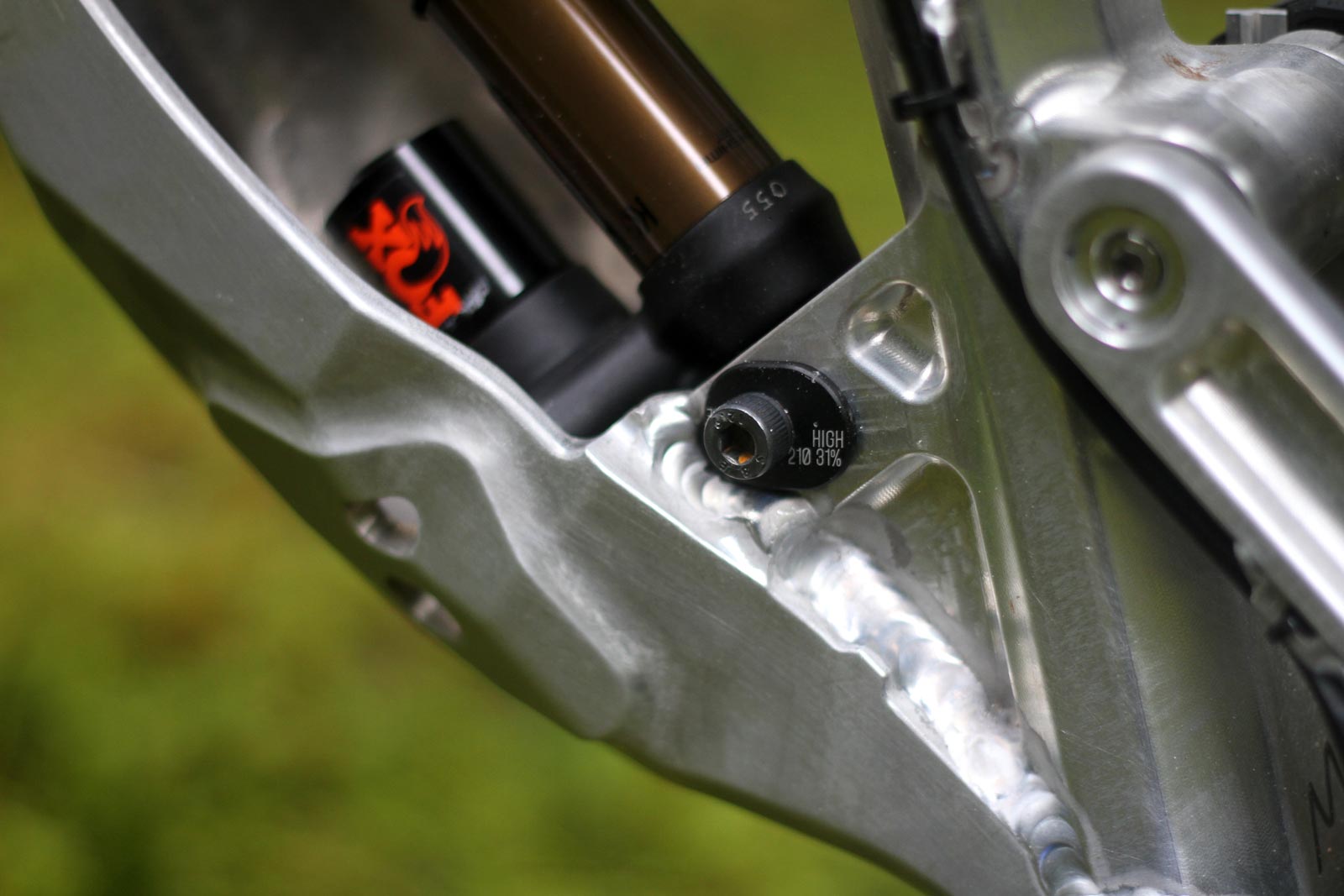
A flip-chip at the lower shock mount permits four possible mounting positions, differing in both their fore-aft and vertical position, affecting linkage progression and bottom bracket height. The flip-chip of Gwin’s bike has “HIGH 210 31%” printed on it, but John was keen to point out that, since the linkage design has moved on recently, those numbers no longer really mean anything.
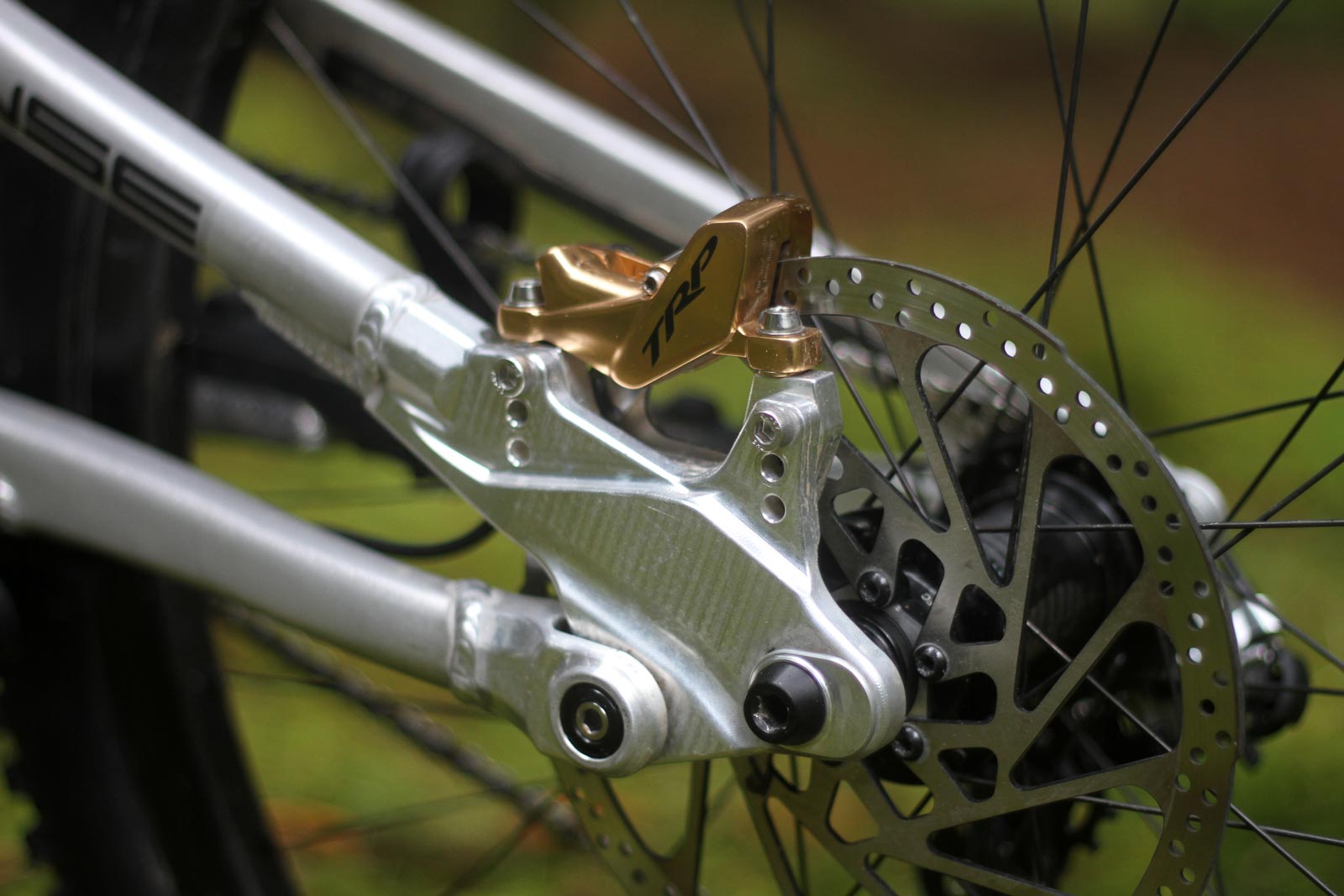
The final location where adjustments can be made is of course the dropouts, where a flip-chip can alter the bike’s rear-center length. There are three possible positions; Aaron opted for the short chainstay position The rear brake can be mounted in three possible positions, in accordance with the three chainstay potions, in order to correct for any changes in rear-center length.
Also spotted on Aaron Gwin’s Intense DH bike was a prototype TRP DH7 derailleur, and some fresh rubber from Vee Tire Co, both of which we shall have more info on shortly.
